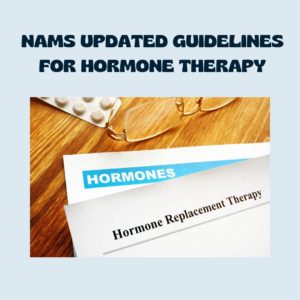
What is the North American Menopause Society and why is it important? The North American Menopause Society (a/k/a NAMS) is the leading nonprofit organization seeking to promote health and quality of life for women in midlife and beyond. They do this through understanding menopause and healthy aging. NAMS is a vital resource for doctors and patients to find the most updated information for Menopause.
NAMS has recently updated its Hormone Therapy Replacement Position Statement. Stephanie S. Faubion, NAMS medical director and lead of the Position Statement Advisory Panel, explains that “[s]ince our last Position Statement on hormone therapy published in 2017, there have been important additions that further clarify the balance of risks and benefits of hormone therapy options for menopause symptoms.” Below are some of the findings that you need to know:
- Hormone Therapy remains the most effective treatment for vasomotor symptoms and the genitourinary syndrome of menopause and has been shown to prevent bone loss and fracture.
- The risks of HRT are different for each woman, depending on type, dose, duration of use, route of administration, timing of initiation, and whether progestogen is used.
- Treatment should be individualized using the best available evidence to maximize benefits and minimize risks, with periodic reevaluation of the benefits and risks of continuing HRT.
- For women younger than 60 or who are within 10 years of menopause and have no contraindications, the benefits outweigh the risks for treating hot flashes and for women with higher-than-average risk of bone loss or fracture.
- For women who initiation hormone therapy after 10 years of menopause onset and are older than 60, the benefit-risk ratio seems less favorable because of the greater absolute risks of coronary heart disease, stroke, venous thromboembolism, and dementia.
- For Genitourinary syndrome of menopause symptoms not relieved by over the counter remedies in women without indications of systemic hormonal therapy, low dose vaginal estrogen or other therapies are recommended.
Vasomotor symptoms are what we call hot flashes, hot flushes or night sweats. Changing levels of estrogen affects multiple ways that the body regulates temperature and hot flashes can be the result. NAMS continues to state that Hormone Therapy is still the most effective treatment for these menopause symptoms.
What is the Genitourinary syndrome? The “Genitourinary syndrome of menopause (GSM) is defined as a collection of symptoms and signs caused by hypoestrogenic changes to the labia majora/minora, clitoris, vestibule/introitus, vagina, urethra, and bladder that occur in menopausal patients. “(3) Think of it as vaginal atrophy, pain or dryness; something that up to 80% of postmenopausal women struggle. Treatments for GSM can include both hormonal and nonhormonal treatments.
What has changed since their 2017 report? First, the report no longer states that hormone therapy should be done at the lowest dose for the shortest amount of time. Instead, NAMS states that an appropriate dose (usually but not always the lowest), type, duration of use, timing of initiation and route of administration is different for each patient and should be reassessed regularly. Second, the statement clarifies that women over 65 may not need to go off hormone therapy just because of their age. NAMS recommends an individual evaluation of the patient before any decision is reached.
Remember to always check with your doctor before starting any hormonal therapy. If you doctor is not answering your questions or addressing your concerns in a way you feel appropriate, please check the North American Menopause Society website for more information and a list of certified menopause practitioners.
Research:
- North American Menopause Society Updates Position Statement on Hormone Therapy, Says Benefits Outweigh Risks for Some Women, breastcancer.org
- Understanding the pathophysiology of vasomotor symptoms (hot flushes and night sweats) that occur in perimenopause, menopause, and postmenopause life stages
- Genitourinary syndrome of menopause (vulvovaginal atrophy): Clinical manifestations and diagnosis